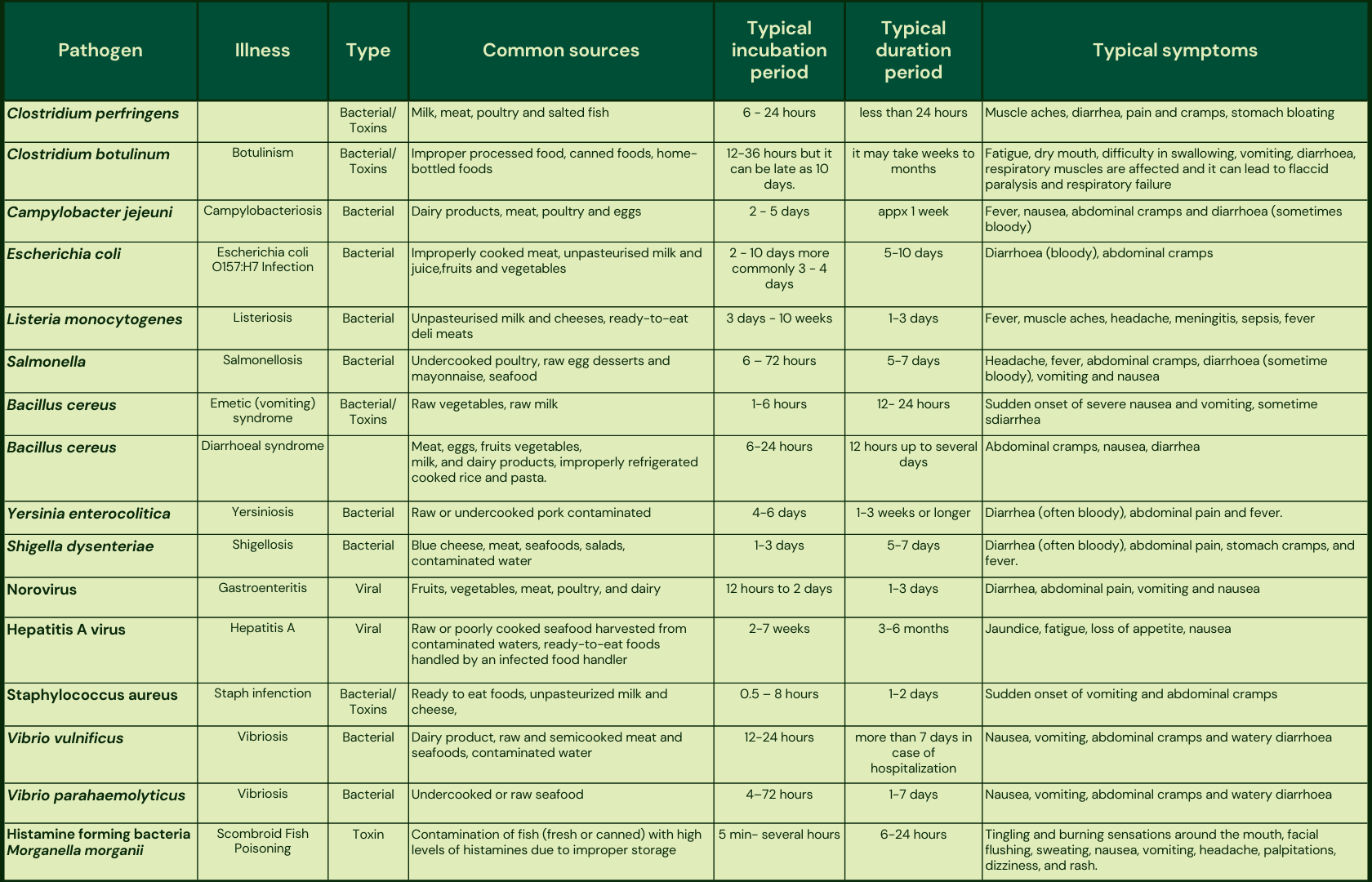Foodborne illnesses: Causes, Common Sources and Symptoms

This post is also available in:
This post is also available in:
![]() Español (Spanish)
Español (Spanish) ![]() Deutsch (German)
Deutsch (German) ![]() हिन्दी (Hindi)
हिन्दी (Hindi) ![]() Ελληνικά (Greek)
Ελληνικά (Greek)
What are Foodborne Illnesses?
Foodborne illness (or disease) is any illness resulting from consuming contaminated food or beverages. The contamination occurs from pathogenic bacteria, parasites, viruses, toxins (mycotoxins, enterotoxins, or natural toxins), or other poisonous chemicals in food.
Foodborne diseases impede socioeconomic development by straining healthcare systems and harming national economies, tourism and trade.
Based on the WHO’s data, almost 1 in 10 people in the world – fall ill after eating contaminated food, and 420,000 die every year. Children under 5 years of age carry 40% of the foodborne disease burden, resulting in approximately 125,000 child deaths yearly.
In the United States, approximately it is estimated that 1 in 6 people experience foodborne illness every year. Around 9.4 million people get sick from foodborne agents. The pathogens that caused the most illnesses were:
- Norovirus (58%),
- nontyphoidal Salmonella spp. (11%),
- Clostridium perfringens (10%),
- Campylobacter spp. (9%).
Regarding hospitalizations, the leading causes of hospitalization were:
- nontyphoidal Salmonella spp. (35%),
- Norovirus (26%),
- Campylobacter spp. (15%),
- Toxoplasma gondii (8%).
As for the deaths related to foodborne illnesses, there is an estimation that 1,300 cases are caused by contaminated food eaten every year. The leading causes of death were:
- nontyphoidal Salmonella spp. (28%),
- T. gondii (24%),
- Listeria monocytogenes (19%),
- Norovirus (11%).
In the EU, in 2021, 4,005 foodborne outbreaks were recorded, while there were more than 33,813 illnesses related to food. Of these, 2,560 were hospitalizations. The most frequent causes were Salmonella, Norovirus and Campylobacter.
Generally, Campylobacter, Clostridium perfrigens, Listeria monocytogenes, Salmonella and Norovirus are responsible for 98% of these deaths.
What are the causes of foodborne diseases?
Foodborne illnesses may be caused by several agents, known as biological hazards, including bacteria, toxins, parasites, viruses, or other agents.
Bacteria: Most foodborne outbreaks are caused by bacteria. Examples are Campylobacter, Escherichia coli, Listeria monocytogenes, Salmonella, Shigella, Bruchella, Clostridium botulinum, Vibrio sp. and Yersinia.
Viruses: Viral infections are responsible for approximately ⅓ of cases of food infections in developed countries. The most common agents are Norovirus, Enterovirus, Hepatovirus, Rotavirus and Adenovirus.
Toxins: Toxins are released by specific bacteria such as Bacillus cereus, Clostridium perfringens, Staphylococcus aureus, Escherichia coli (Shigatoxin) and Clostridium botulinum. Also, examples of toxins produced by specific fungal species, known as mycotoxins, are aflatoxin, ochratoxin, zearalenone, etc. Natural toxins are produced by animals or plants, such as alkaloids, mushroom toxins, shellfish toxins, grayanotoxin etc.
Parasites: Examples are Toxoplasma, Cryptosporidium, Cyclospora, Trichinella, Anisakis and Giardia
Other causative agents: Histamine and marine biotoxins may accidentally contaminate certain types of fish and fishery products if they are not correctly preserved, causing food poisoning and foodborne outbreaks.
What is the difference between food infection and food poisoning?
Foodborne illness can be categorized into three categories:
- food infection,
- food intoxication (or food poisoning),
- food intoxification
Food infection occurs when people consume food that contains live bacteria that once ingested, they start growing in the digestive tract (e.g Salmonella or Listeria).
Food intoxication occurs when people consume food that contains toxins produced by the bacteria (e.g. Clostridium botulinum).
Food intoxification occurs when people consume food that contains live bacterial cells. These bacteria cells, when ingested, they start producing toxins in the body (e.g., Clostridium perfringens)
What are the most common symptoms of foodborne diseases?
The symptoms of foodborne diseases vary depending on the case. Different pathogens have different symptoms. Please see the table below for more detailed information. The most common symptoms of foodborne illness are:
- Diarrhea (sometimes bloody),
- Vomiting,
- Nausea,
- Fever,
- Abdominal cramps,
- Joint/back aches,
- Fatigue
Which are the foods that may cause foodborne outbreaks?
Even though harmful pathogens or toxins can potentially contaminate all foods, there are some foods that are more frequently contaminated.
Water: Many cases have been reported from drinking contaminated water. Most of the pathogens can be transferred through water and contaminate the fruits and vegetables we eat or directly the water we drink. Examples of pathogens are Shigella, Escherichia, and Vibrio sp.
Fruits and Vegetables: They can be contaminated with animal waste or unclean water. Unpasteurized fruit juices can also be contaminated if there are pathogens on the fruit used to make the juice. Mainly associated with pathogens such as Salmonella, Clostridium, Botulinum toxin, Toxoplasma and viruses.
(Poultry) Eggs: Often are associated with Salmonella infection, especially when they are consumed raw or lightly cooked.
Meat and Meat Products: They are at high risk, especially if they are not well cooked or there is cross-contamination from the equipment used. Salmonella, Campylobacter, and Listeria, but also viruses.
Crustaceans, Shellfish, Molluscs, and Fish: Mainly, there are implicated in outbreaks caused by norovirus, Vibrius sp. and bacterial toxins.
Multi- Ingredients foods: Examples are bakery products, sweets, and chocolate. Additionally in this category are also included buffet meals, ready-to-eat meals etc. Mainly most common pathogens here are Salmonella or Norovirus, however, it is also possible to have Listeria or Staphylococcus.
Who is at high risk of suffering from foodborne diseases?
Generally, everyone that eats contaminated food is at risk for foodborne illness. However, there are some groups of people that are at higher risk than normal.
These groups are:
- Elderly people
- Infants and young children
- Pregnant woman
- Cancer patients
- People with liver diseases
- People with diabetes
- People on medicine that affect the immune system
- People with AIDS
- People that take antacids
Why and where food contamination may occur?
The processes that cause microbial contamination are intricate, involving numerous potential sources throughout the entire food production cycle. Contamination can arise from water as well, especially when it is used for pre-harvest irrigation or washing food items. However, it is important to note that food contamination is unintentional and occurs when proper hygiene practices are not maintained during both the production and preparation stages.
At primary production (on the farm) level. At the farm and during primary production, both vegetables and animals can be exposed to various forms of contamination. Pathogens can infect animals without causing noticeable illness to them, yet they can still contaminate the resulting food. Similarly, milk can undergo contamination during the process of milking.
At the slaughterhouse. At the slaughterhouse, improper handling practices and inadequate hygiene measures can contaminate meat and carcasses.
During processing. During the food processing stage, contamination can occur when food comes into contact with surfaces and tools that haven’t been adequately cleaned and sanitized. Additionally, contamination can arise from food handlers who are infected with pathogens.
During distribution and food preparation. Contamination during distribution and food preparation primarily occurs due to inadequate hygiene practices, particularly in relation to food storage, handling, and preparation.
In restaurants, canteens, takeaways and domestic settings. Dishes can become contaminated during the final preparation stage due to various factors. Improper use of utensils, poorly cleaned and disinfected surfaces, food from unsafe sources, non-hygienic handling of ingredients, and temperature mishandling during cooking and/or storage can all contribute to contamination.
How to minimize the risk of having a foodborne disease?
Control of foodborne illnesses relies on the measures of avoiding contaminated food, eliminating contaminants, and halting the further dissemination of harmful agents. There are many methods that are used to minimize the risk of having a foodborne illness.
Depending on the facilities you are in, you can apply different preventive measures. The most common are appropriate cooking and storage methods (read about home food preservation) and maintaining proper personal hygiene among food handlers and on domestic premises.

Please take into consideration that the table above is indicative. More sources or different incubation and duration periods exist depending on the case.
References
Scallan, E., Hoekstra, R. M., Angulo, F. J., Tauxe, R. V., Widdowson, M., Roy, S. L….Griffin, P. M. (2011). Foodborne Illness Acquired in the United States—Major Pathogens. Emerging Infectious Diseases, 17(1), 7-15. https://doi.org/10.3201/eid1701.p11101.
CDC, 2018, Estimates of foodborne Illness in the US
https://www.efsa.europa.eu/en/microstrategy/FBO-dashboard
WHO, 2019, 23 million people falling ill from unsafe food each year in Europe is just the tip of the iceberg, The burden of foodborne diseases in the WHO European Region (2017), Information on the five keys to safer food.
NSW, Food Authority, Foodborne illness pathogens, https://www.foodauthority.nsw.gov.au/consumer/food-poisoning/foodborne-illness-pathogens
CSUN, California State University, Northridge, Food Safety | Food Borne Illness
Per Einar Granum , Terje Lund, Bacillus cereus and its food poisoning toxins, FEMS Microbiology Letters, Volume 157, Issue 2, December 1997, Pages 223–228, https://doi.org/10.1111/j.1574-6968.1997.tb12776.x
Chong YP, Moon SM, Bang KM, Park HJ, Park SY, Kim MN, Park KH, Kim SH, Lee SO, Choi SH, Jeong JY, Woo JH, Kim YS. Treatment duration for uncomplicated Staphylococcus aureus bacteremia to prevent relapse: analysis of a prospective observational cohort study. Antimicrob Agents Chemother. 2013 Mar;57(3):1150-6. doi: 10.1128/AAC.01021-12. Epub 2012 Dec 17. PMID: 23254436; PMCID: PMC3591920.
Infectious Disease Epidemiology, Prevention and Control Division, Minnesota Department of Health Fact Sheet about Norovirus,
Infectious Disease Epidemiology, Prevention and Control Division, Minnesota Department of Health Fact Sheet about Staph disease,
https://www.health.state.mn.us/diseases/staph/basics.html
Infectious Disease Epidemiology, Prevention and Control Division, Minnesota Department of Health Fact Sheet about Salmonellosis,
https://www.health.state.mn.us/diseases/salmonellosis/index.html
UNIVERSITY of NEBRASKA–LINCOLN extension, https://food.unl.edu/yersinia-enterocolitica
Tortorella V, Masciari P, Pezzi M, Mola A, Tiburzi SP, Zinzi MC, Scozzafava A, Verre M. Histamine poisoning from ingestion of fish or scombroid syndrome. Case Rep Emerg Med. 2014;2014:482531. doi: 10.1155/2014/482531. Epub 2014 Dec 7. PMID: 25544905; PMCID: PMC4273511.
New York State Department of Health, Vibriosis Fact Sheet, https://www.health.ny.gov/diseases/communicable/vibriosis/fact_sheet.htm#:~:text=Symptoms%20usually%20appear%20within%2012,result%20in%20hospitalization%20or%20death.
WHO, 2018, Botulism, https://www.who.int/news-room/fact-sheets/detail/botulism#:~:text=Exposure%20and%20transmission-,Foodborne%20botulism,soil%2C%20river%20and%20sea%20water.
Centers for disease control and Prevention, Vibrio species causing vibriosis
Wei Yu, Xiaomin Shen, Hongying Pan, Tingting Xiao, Ping Shen, Yonghong Xiao, Clinical features and treatment of patients with Vibrio vulnificus infection, International Journal of Infectious Diseases, Volume 59, 2017, Pages 1-6, ISSN 1201-9712, https://doi.org/10.1016/j.ijid.2017.03.017.








































































